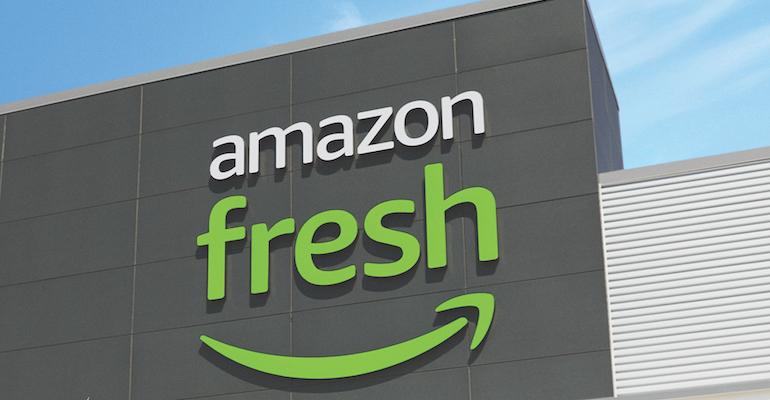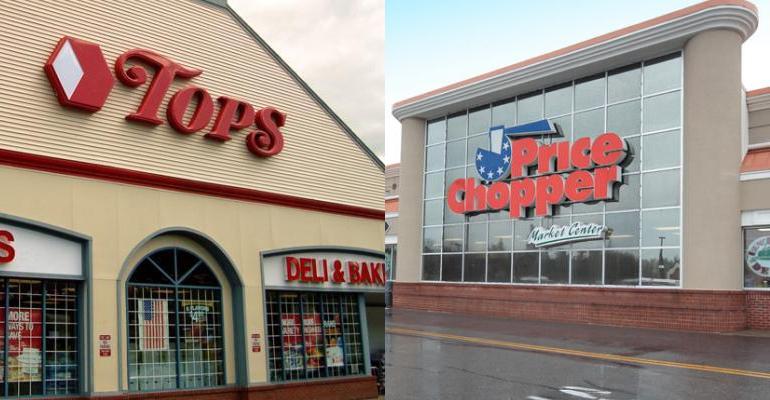Scott Moses is a managing director and head of grocery, pharmacy and restaurants investment banking at Solomon Partners, a New York-based M&A investment banking advisory firm. He writes a quarterly column for Supermarket News about sector trends, including operating, valuation and strategic dynamics.
 The mandate of the Federal Trade Commission to protect consumers from anti-competitive behavior is critically important, particularly during a difficult inflationary time. However, when evaluating grocery mergers, the FTC continues to define the traditional “grocery market” in a narrow manner — supermarkets, which is plainly inconsistent with the realities of the present-day marketplace.
The mandate of the Federal Trade Commission to protect consumers from anti-competitive behavior is critically important, particularly during a difficult inflationary time. However, when evaluating grocery mergers, the FTC continues to define the traditional “grocery market” in a narrow manner — supermarkets, which is plainly inconsistent with the realities of the present-day marketplace.
This directly undermines the existential scale-building efforts of traditional regional supermarkets, whose viability challenges from much larger, far better-capitalized, nontraditional “Grocery Giants” like Amazon, Walmart, Target, Costco Wholesale, Aldi and Dollar General have been well-documented.
Ironically, this calculus effectively benefits precisely the same Giants that the FTC has professed the need to rein in (namely Amazon, America’s fifth-largest grocer, allowing the Giants to get bigger, stronger, take more customers and make it harder for the smaller traditional operators — whose heroism fed thousands of American communities during the pandemic and countless previous crises — to survive in the long-run.
When grocers merge, the combined business’ stores almost always still compete with a long list of traditional and nontraditional grocers, including supercenters, club stores, drugstores, dollar stores and other discount grocers. Amazon, Walmart, Target and Costco are also America’s largest online operators. They all offer delivery services that meaningfully widen the radius of customers for whom they are able to compete, in many cases without having a store nearby. Kroger is now opening Ocado facilities in various markets where it does not have stores.
The FTC has historically argued that “other types of retailers” such as discount grocers — such as Aldi, Lidl, Dollar General, Dollar Tree/Family Dollar — and warehouse club stores like Sam’s Club (Walmart), Costco and BJ’s Wholesale are not part of the relevant grocery “market” because they do not have a supermarket’s full complement of products and services. They are not viewed by FTC orthodoxy to be “adequate substitutes for supermarkets” and therefore are excluded from the FTC’s view of the “grocery market” when evaluating grocery mergers, as are online grocers, whose rapidly growing sales are essentially excluded.
While the FTC rightfully aims to ensure that grocers do not employ monopolistic pricing power, in 2022 (not 1992, when this calculus was more fairly employed), there has never been so much pricing transparency quite literally at our fingertips. As such, it is nearly impossible for a small regional grocer to meaningfully raise prices without losing countless customers to the lower-priced, ubiquitous nontraditional operators from whom they can order groceries online, at will, in most U.S. markets. Online grocery has tripled in the past three years and is expected to double again in the next five years.

Despite their market power, big players like mass merchants, warehouse clubs, discount grocers, dollar chains and online sellers aren’t being factored into the FTC’s equation for assessing grocery competition.
Hopefully, there are some changes coming.
Last week, the Federal Trade Commission held its Merger Guidelines Listening Forum videoconference to hear from members of the public about the effects of mergers and acquisitions on a range of market participants. FTC Chair Lina Khan and FTC Commissioners Noah Phillips, Rebecca Slaughter, Christine Wilson and Alvaro Bedoya all attended the event, which included brief remarks from distinguished speakers from a wide range of industries. There were a variety of astute, important points made that will hopefully help advance the FTC’s “grocery market” definition calculus to reflect modern market dynamics.
Commissioner Phillips, in particular, provided insightful perspective on the current state of the grocery industry, consumer challenges and the importance of mergers in enabling grocers to become large enough to be able to afford to keep prices lower for customers and mitigate the impact of the significant inflation being experienced across the country:
“Our nation is emerging from one crisis, the COVID-19 pandemic, and is well into another. As we face historic inflation, Americans are struggling to fill up their gas tanks and feed their families. We want to encourage companies big and small to enter and grow to meet consumer demand during this time. We want them to be more efficient so that they can drive down costs and pass the savings on to consumers,” Phillips said.
“Competition-enhancing mergers and acquisitions is one way they do that. M&A benefits consumers by spurring innovation, improving quality and lowering prices,” he explained. “Smaller firms can join forces to compete more effectively and efficiently against larger rivals; combining can put financially struggling firms on firmer footing and lower their cost of [the] capital. … They need to spend in order to grow. Traditional retailers, for example, have seen reduced investment and bankruptcy as they face competition from the Amazons and Walmarts of the world.
“Combining — merging — can help them compete,” Phillips said, adding that “discouraging efficiency and failing to put consumers first will mean higher prices.”

Amazon, already a dominant grocery e-tailer, is now extending its brick-and-mortar reach with the fast-growing Amazon Fresh supermarket banner.
One speaker in the forum was Mark Gross, a 25-year grocery industry veteran and co-chairman of Northeast Grocery Inc. (Price Chopper/Market 32, Tops Friendly Markets), executive chairman of Southeastern Grocers (Winn-Dixie, Harveys Supermarket, Fresco y Mas), a director at Acosta and CEO of Kernel Group Holdings. He also is a former CEO of distributor Supervalu (now part of United Natural Foods Inc.) and former co-president of distributor C&S Wholesale Grocers.
Gross began his testimony by articulating three key conclusions:
1. “We have to fully update our definition of the grocery market to include all nontraditional grocers, whether they offer a full shop or not.”
2. “We need to understand the economic dominance of these nontraditional grocers and how they assert that power.”
3. “To foster competition with the Grocery Giants, we need to be more accommodating of regional grocers’ merger activity.”
Of the top 15 U.S. grocery sellers, Gross noted, only five are traditional supermarkets. He explained that the growth in nontraditional grocers has resulted in the reduction of traditional grocery stores. He added that nontraditional grocers are the primary store for most consumers, who shop at multiple channels and banners every week, and that fact does not seem properly reflected when the FTC measures the grocery market and market share.
“Because of the economic dominance of the grocery market by a handful of companies,” Gross argued, “the market has to be viewed in its entirety of who is competing in this space and who yields market power.”
In demonstrating the economic dominance of America’s Grocery Giants, Gross observed that Walmart’s capex spend last year was $13 billion, more than half of which (over $7 billion) was on technology. A regional grocer, he noted, will spend at most $200 million on capex, of which only about $20 million is on technology. That $20 million spend versus $7 billion is “disproportionate,” he said.
Gross also talked about the merger completed last year between Price Chopper/Market 32 and Tops Friendly Markets in upstate New York (on which, for full disclosure, I served as financial adviser to Price Chopper). For background, Tops’ operating pressures from Grocery Giants such as Amazon, Walmart, Aldi, Dollar General and Family Dollar led it into bankruptcy in 2018. Tops was fortunately able to avoid liquidation and exit bankruptcy in 2019, but remained too small to properly compete with the fast-growing Grocery Giants, who have a much lower cost of capital and nearly unlimited capacity to make investments in price, wages, marketing, technology and growth.
“The transaction was pro-competitive, enabling stores to offer better choice for consumers vis-à-vis the Giants and enabling the merged company to generate various improvements and leverage technology spend, which helps us to operate more effectively and better serve our customers and our 30,000 associates … in over 100 communities,” Gross asserted.

The merger of Price Chopper/Market 32 and Tops Friendly Markets united two strong, local supermarket brands into one company (Northeast Grocery Inc.) with more scale to compete.
Finally, in arguing that the FTC should properly recognize the market dominance of the Grocery Giants and their ubiquity as leading online grocers, Gross lamented, “Our team spent nine months explaining this to the [FTC] staff and compliance officers. … We spent countless hours and millions of dollars demonstrating that Aldi and Dollar General are bona fide grocers who sell the same merchandise we do. … Amazon, Walmart and Target are the largest American online grocers, and they sell a lot of food in our markets.”
Another speaker, Stephanie Martz, chief administrative officer and general counsel of the National Retail Federation, made an important point regarding the calculus that the FTC uses in evaluating the competitive market for potential mergers She argued that the FTC must also incorporate e-commerce competitors as well as brick-and-mortar players.
“I can’t emphasize this enough,” Martz noted. “It seems inconsistent to express concern, on the one hand, that some of these e-commerce players are too large and on the other fail to account for their effect on individual market segments.”.
Some have argued to the FTC in previous sessions that consolidation among smaller traditional grocers should be limited and that the government should instead rein in the conduct of the Grocery Giants like Amazon and Walmart. Specifically, merger opponents argue that the only path to more effective competition in the market is to more aggressively enforce the Robinson-Patman Act, which would, they suggest, equalize the wholesale price of grocery staples. Their argument is that if a small grocer pays the same price for milk as does Walmart, competition problems will take care of themselves.
There are various flaws in this argument. But I would focus one in particular: It would not level the playing field as its proponents suggest. While Grocery Giants do use their scale to negotiate lower costs from suppliers, equalizing the cost of those products would not alleviate the gross difference in scale enjoyed by the Giants. The inherent benefits of that scale — including a lower cost of capital, more efficient distribution and logistics, cheaper store and corporate contracts, and higher profitability from basic fixed-cost leverage — gives these Giants an extraordinary advantage that won’t be undone by effectively raising the price of milk at Walmart or Target. To the contrary, this would just exacerbate the inflationary challenges consumers are experiencing.
However, when smaller traditional grocers are allowed to gain the benefits of scale, consumers benefit because there are more options available to them to shop at more grocers that are more efficient and can offer lower prices on more goods. Larger, consolidated entities (albeit still much smaller than the Grocery Giants) might finally be able to exert some restraint on the Giants, which have not faced serious competition for many years and continue to grow at a staggering rate.
After America’s regional grocers stores stepped up to feed their nearly locked-down communities at the height of the pandemic and for the past two-plus years since, it is surprising there still is not more clear recognition among regulators of the critical role that smaller regional grocers play serving customers in crisis after crisis; the existential challenges they face; the consumer benefits of enabling them to grow and become more efficient; and the fact that, without more scale to compete, many of them may not be around in the next crisis to help feed our communities. The department store industry remains a clearly analogous cautionary tale that folks should remember when considering the scale that regional grocers are trying to build in order to better compete with the Grocery Giants and continue to serve as pillars of thousands of American communities.


